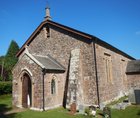St. Luke's, Posbury
About Posbury
The name Posbury is of uncertain derivation, but is probably connected with the British proper name Possa. Although Posbury does not rate a mention in the Domesday Book, being part of the tithing of Youweton (Uton) in Crediton Hamlets, nevertheless, it was a site of continuous occupation for many hundres of years before that date.
First settled in the Iron Age, it remained a British hill fort throughout the Roman occupation of Britain and the dark ages which followed. As the colonisation of Devon by the Saxons crept westwards in the seventh century, Posbury remained an outpost of the kingdom of the Dumnonii until, in 661 AD, King Cenwalh of the Saxons fought and won a battle at Posbury and drove the British off the fertile redlands westwards.
Nothing more is known of activities in the area until the twelth century when a quarry was opened up to obtain the warm, red/brown igneous rock, much of which was used in building Crediton Church and is to be found, particularly in the door arches of other churches in the neighbourhood. There appears to be no details of the working quarry, but lying within the manor of Crediton no doubt it was a valuable asset of the Bishop of Exeter, Lord of the manor of Crediton, which was virtually co-existent with Crediton Hamlets. When in 1871 the churchyard of Crediton Church was extended eastwards by incorporating the road then known as Palace Road or Lane and part of Brown Meadow, making a new road now known as Church Lane, the conveyance of the land required that the wall to be built on the east side of the new road should be of Posbury stone.
By the eighteenth century Posbury formed part of the Tuckfield Estate. The Tuckfield family had long been established in the locality, members of the family appeared in the subsidy rolls of both 1524 and 1547. In the former, John Tuckfield was taxed on goods valued at £13, considerable wealth at that time. In the seventeeth century a Mr Tuckfield lived in the largest house in the parish of Thorverton, paying tax on eight hearths according to the Hearth Tax Rolls of 1674. Henry Tuckfield suceeded to the estate and when he died in 1797 he bequeathed the estate to Richard Hippisley who assumed the name and arms of Tuckfield. In 1800 Richard married Charlotte, the fifth daughter of Sir John Mordaunt, in London and together they lived at Little Fulford until 1815, when Richard built the mansion known as Shobrooke Park. Friends of the Tuckfields were the Fursdons of Fursdon and during a visit by Mrs Tuckfield to see Grace Fursdon, the eldest daughter of Squire Fursdon she met a deaf and dumb protege of Miss Fursdon. This child elicited much sympathy and interest on the part of Mrs Tuckfield, so much so that she journeyed to Paris to learn at the Institution for the deaf and dumb run by the venerable Abbe Sicard, how such a child might be taught. Greatly impressed by what she saw she returned to Shobrooke, sought out two more similarly affected children and taught them herself. Her success aroused considerable interest and support, resulting, in 1824, in the establishment of a school in Alphington Road, Exeter from which grew the present Royal West of England School for the deaf. This exercise clearly stimulated Mrs Tuckfields interest in education and during the next few years she wrote a series of articles which were eventually published in a book entitled "Education for the people". In 1835 she gathered some young male students at Posbury to be trained as teachers.
For more about Mrs Tuckfields activities in education click here.
